STEAM@Stipe
By Brianna Chenevey

STEAM@Stipe
By Brianna Chenevey
Stipe Elementary School provides STEAM-based learning, an approach to learning that incorporates Science, Technology, Engineering, the Arts, and Mathematics. This type of project-based learning provides Stipe students, grades kindergarten through sixth, with tools and methods to explore new ways of problem solving, design, innovation, and implementation. They are encouraged to think outside the box and let their imagination run wild. In this project-based, “learn by doing” approach, students move toward the unknown, try something new, and see where it takes them.
Stipe began holding Family Engagement Sessions in April 2019, where they learned about STEAM and invited the community to join in the hands-on experiences. By August 2019, Stipe had partnered with Resource Area for Teachers (RAFT). Teachers began learning how to implement a Makerspace challenge and engage students in Makerspace activities. That November, Stipe officially became the STEAM@Stipe community, and the program was scheduled to begin the following school year (2020-2021). The STEAM@Stipe community, consisting of teachers, staff, parents, and students, got busy and began building and organizing the space that would soon become the STEAM@Stipe Makerspace. Students worked hard to build workbenches on wheels, as teachers, staff, and parents helped support and guide them along the way.
Although the 2020-2021 school year began in Distance Learning, teachers continued to model project-based learning. STEAM@Stipe Coordinator, Michelle Link, joined the team and began to help guide and support this type of teaching and learning. Makerspace shifted to creating home kits for the students to work on at home, as Link continued coordinating with RAFT, STEAM@Stipe’s Parent Faculty Association (PFA) Team, local business partners, and school services to help provide materials, making hands-on learning available to all students.
STEAM@Stipe’s first ever, virtual Maker Night took place last October. Over 40 families joined the virtual event. This was also the first opportunity to get the community involved in Maker Night and spread the culture. Food operates as an expression of cultural identity and brings feelings of connection and togetherness. STEAM@Stipe’s PFA had reached out to Link, and once she knew that she would have their support in the process, the first Maker Night was paired with a PFA event and became “Flautas Fun + Maker Night”. Families were encouraged to pre-order flautas through the Stipe PFA website. At pick-up, they were provided with a free maker kit to build at home with their family. They also had the choice to log on and build with other STEAM@Stipe families. “This was the perfect opportunity to launch something like that,” Link says. “When getting together helps bind the culture of the school, we had to come up with a way to still make it happen, only virtually.”
Today, STEAM@Stipe continues to collaborate with RAFT, PFA, the Boys and Girls Club, and School Linked Services (SLS) for monthly virtual Maker Nights. “The more organizations we have involved, the more successful this will be.” Link is always planning with sustainability in mind, in hopes that this collaboration will continue for years. “Teachers are doing their best to create unique experiences for their students by incorporating STEAM into their distance learning classrooms. It was the perfect time for trying something new for our community, too.”
Since there was never a way to anticipate if or how the virtual program would grow, Link has faced some challenges along the way. Over the past five months, the family turnouts have continued to increase, making the buy-in and growth of the program difficult to gauge. In turn, this has impacted the supply of the Maker Night kits. Additionally, the virtual events were initially meant to feel less like a classroom and more entertaining for the students, yet with over 100 community members attending, the students are now requested to remain on mute and use the chat box to share their experiences.
Maker Nights are often planned around what kits are available as well as any cultural events that are coming up, with the intention of creating a unique experience for STEAM@Stipe and the culture of the school. According to Link, “The planning is a lot of fun because we are always thinking about our students and how to include their cultural identity in order to make it fun and weave in the maker-mindset, while building a cultural understanding of what STEAM@Stipe means.” Maker Kits are made available to families the week of the event. In December, students designed piñatas for Las Posadas, a longstanding Stipe tradition. For this month’s event, held on St. Patrick’s Day, the students created their very own leprechaun trap.
Another relatively new and exciting virtual event held by the STEAM@Stipe community is STEAM IRL. The first STEAM IRL event took place in February. Storytellers Binh Do and Ryan Kawamoto shared the process of creating their graphic novel, "Mai" based on the Do Family's 1981 immigration from Vietnam to the United States. The second STEAM IRL event took place at the end of March. Students logged in to learn about how three local high school students began a non-profit organization to use mechanical engineering and 3D printing technology to create and deliver face shields to frontline medical professionals during the global pandemic. For more information, check out STEAM@Stipe on Twitter and the new STEAM@Stipe website.